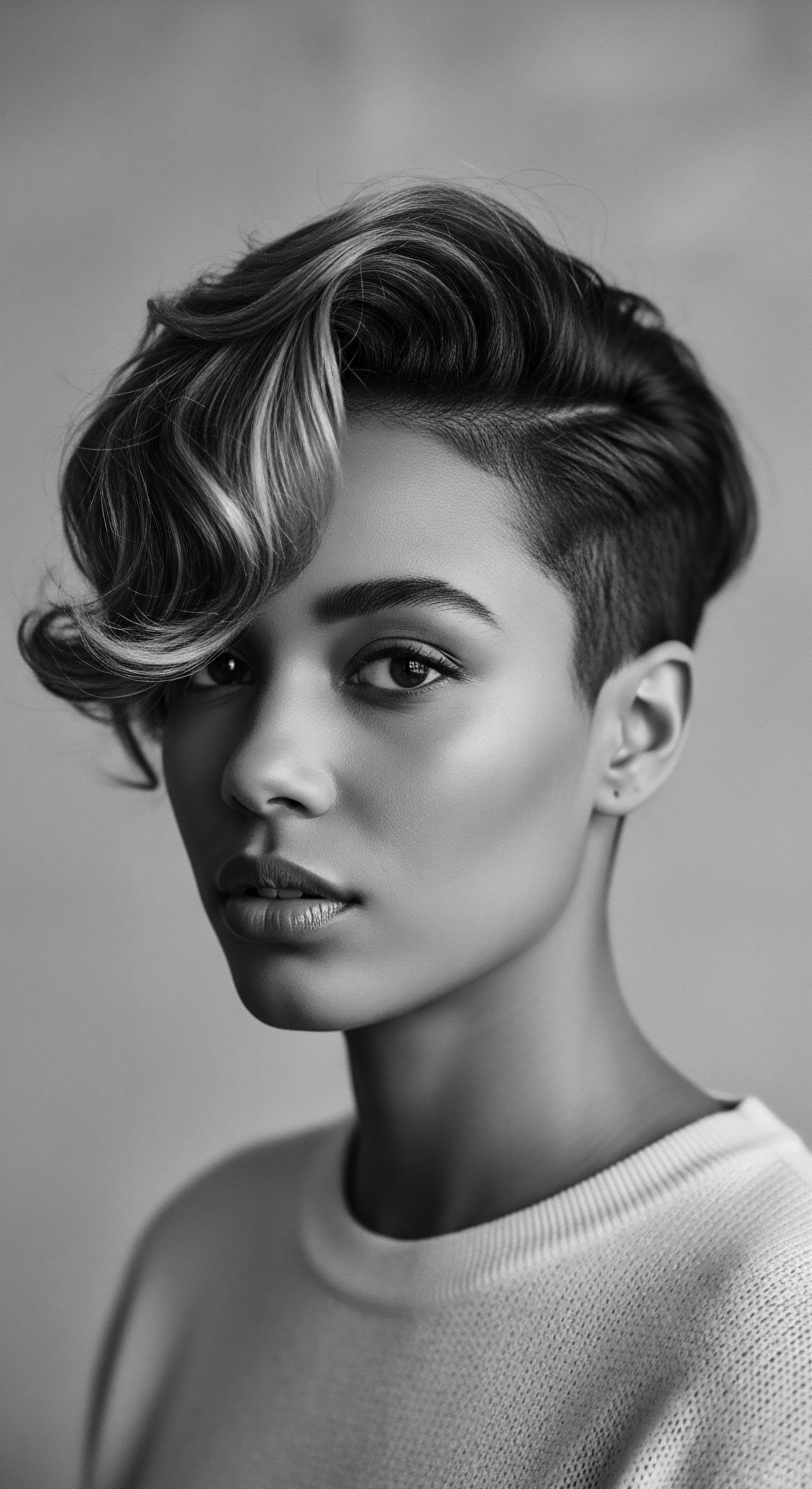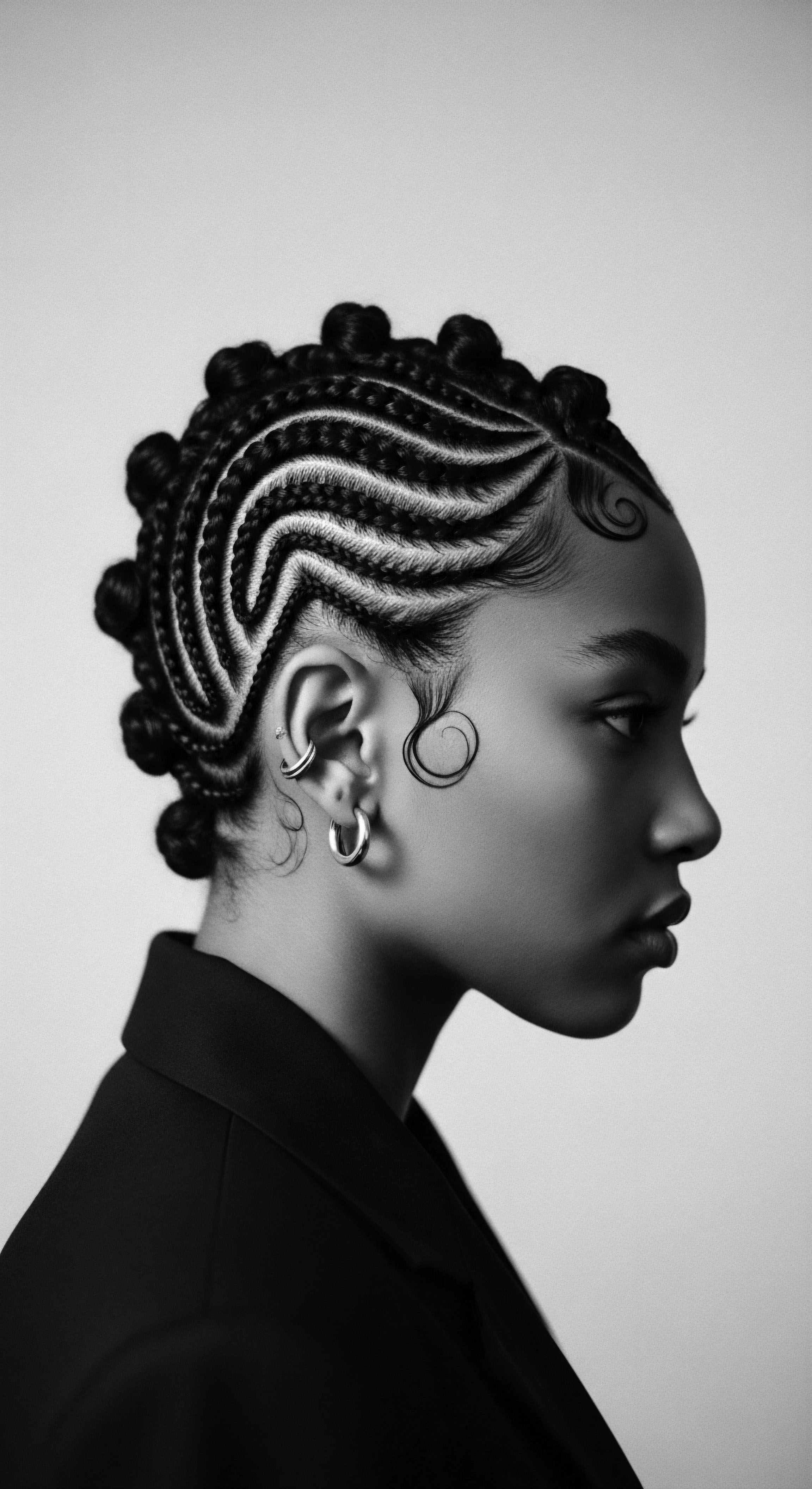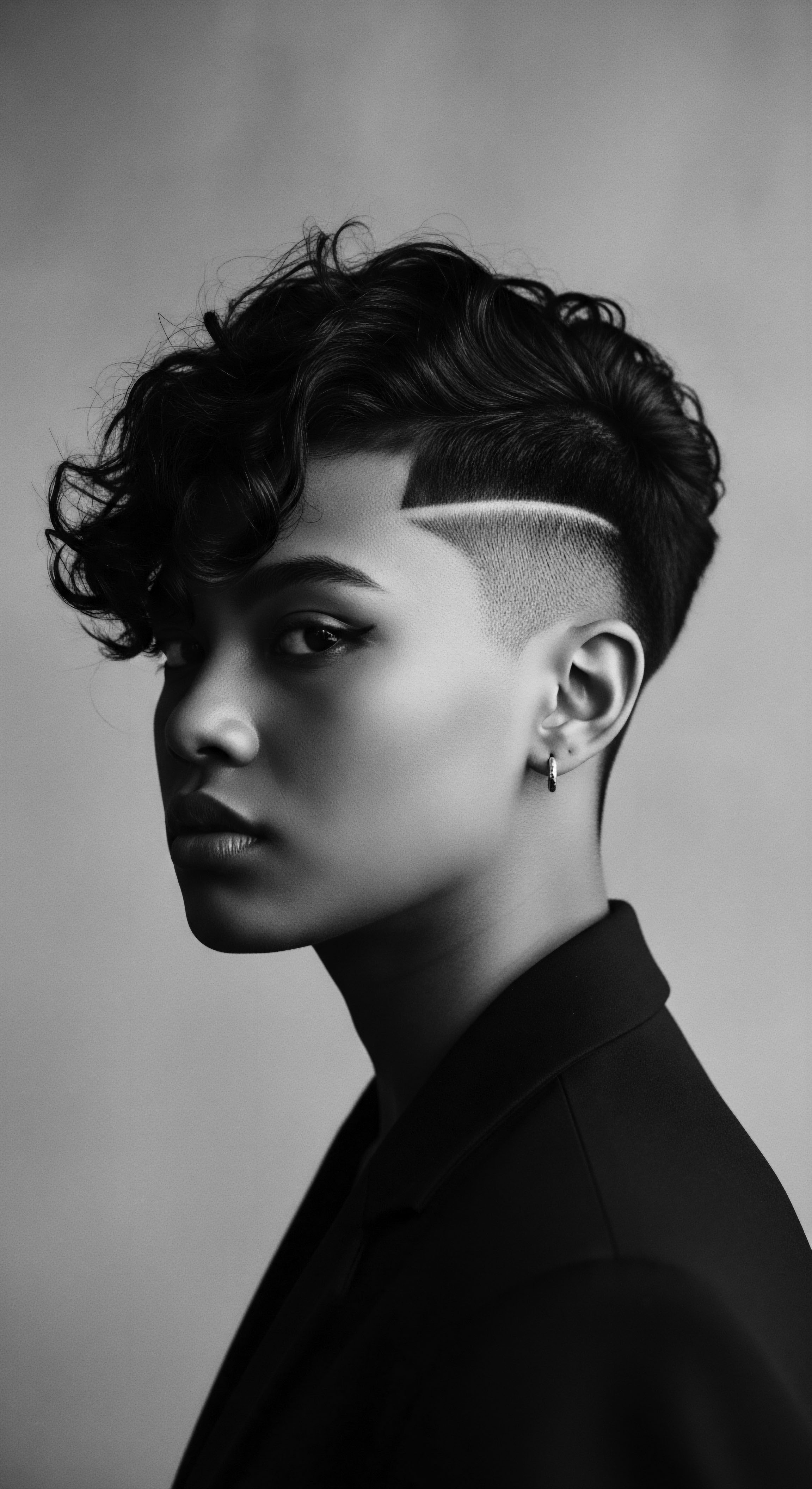
Fundamentals
The concept of Comb Design, within Roothea’s living library, reaches far beyond the mere physical object; it is an interpretation of the intricate relationship between a tool, the unique characteristics of textured hair, and the enduring heritage of care practices. At its most fundamental, a comb is an instrument with a series of teeth, typically rigid, used for arranging, cleaning, and securing hair. Its primary meaning rests in its utility for detangling and smoothing strands, a seemingly simple function that gains profound significance when considering the delicate, coily, and often dense nature of textured hair.
The very design of a comb, even in its most basic form, speaks to an understanding of the hair it is meant to serve. For centuries, before any scientific classifications, ancestral communities intuitively crafted tools that respected the natural curl patterns and strength of their hair. This early recognition of specific hair needs laid the groundwork for what we now understand as intentional Comb Design. It is a delineation of how form follows function, yet always infused with the wisdom of generations.
Comb Design is the deliberate shaping of a hair tool, deeply informed by the specific needs of textured hair and rooted in ancestral practices of care and identity.
Early combs, discovered in ancient Sudan and Egypt (Kemet and Kush), dating back over 6,000 years, reveal not just a practical purpose but also a deep reverence for hair. These initial artifacts, often carved from bone or hippopotamus ivory, sometimes featured animal motifs, suggesting their role extended beyond mere grooming to include decorative or symbolic purposes. This ancient evidence clarifies that the designation of a comb was never solely about its physical structure, but also about its place within a community’s understanding of beauty and connection to the natural world.

The Elemental Connection to Textured Hair
The inherent qualities of textured hair, with its diverse curl patterns ranging from waves to tight coils, demand specific considerations in tool design. Unlike straighter hair types, coily strands possess natural points of entanglement and require gentle handling to preserve their integrity and minimize breakage. The earliest Comb Designs, whether in Africa or among Indigenous peoples globally, reflect an intuitive understanding of these biological realities. They were often crafted with ❉
- Wide-Set Teeth ❉ To navigate the natural clumping and coiling of textured hair without tearing or excessive friction.
- Smooth, Rounded Edges ❉ To glide through hair, protecting the delicate cuticle layer.
- Durable Materials ❉ To withstand the resistance of dense, resilient hair while offering a comfortable grip for the user.
This foundational comprehension of hair’s elemental biology, echoing from the source of ancestral practices, forms the bedrock of Comb Design. It is a testament to the ancestral ingenuity that recognized the unique needs of textured hair and responded with tools designed for both efficacy and preservation.

Intermediate
Moving beyond the rudimentary understanding, the intermediate meaning of Comb Design involves a deeper appreciation for its evolution across cultures and its nuanced role in shaping hair care rituals. It is an exploration of how various societies, particularly those with a rich heritage of textured hair, adapted and refined comb forms, imbuing them with layers of cultural significance. The very term “Comb Design” begins to encompass not just the physical blueprint, but the historical and communal narrative woven into each iteration.
The refinement of Comb Design often mirrored the sophistication of hairstyles and the specific societal functions hair served. In many West African traditions, for instance, hair was far more than an aesthetic feature; it communicated age, marital status, tribal identity, and even spiritual beliefs. The combs used to create these elaborate styles were themselves works of art, often hand-carved with symbols that spoke volumes about the wearer’s lineage or the community’s values. This period of development demonstrates a profound connection between the tool, the hair, and the collective identity, where the comb became a tender thread linking individuals to their heritage.
Comb Design, beyond its basic utility, is a historical artifact reflecting cultural identity, evolving beauty standards, and communal hair care traditions across the globe.

Cultural Variations in Comb Design and Materials
Across the African continent and its diaspora, diverse environmental conditions and available resources influenced the materials and forms of combs. The materials chosen were not arbitrary; they often held spiritual significance or were prized for their practical properties.
- Wood ❉ Readily available, wood allowed for intricate carvings and was gentle on the hair. In many traditions, specific woods were chosen for their perceived properties or sacred associations.
- Bone and Ivory ❉ Durable and capable of fine detail, bone and ivory combs were often reserved for royalty or individuals of high status, reflecting the societal hierarchy.
- Metal ❉ Less common in ancient times for combs due to difficulty in shaping, but eventually adopted for specific applications, particularly heated tools for styling.
The evolution of comb forms also shows regional distinctions. In Ghana, the Dua’afe, a wooden comb, remains linked to femininity and beauty, while traditional Yoruba combs, with their long teeth and distinct necks, were given as gifts signifying friendship or good fortune in West African countries like Nigeria, Benin, Togo, and Ivory Coast. These examples illustrate how the design of a comb is not a universal constant but a culturally specific expression of care and connection.

The Transition from Craft to Commodity
As societies progressed and global exchanges intensified, the production of combs shifted from artisanal craft to mass commodity. The advent of new materials and manufacturing techniques transformed how combs were made and accessed. This transition, while making combs more widely available, also introduced a different dynamic to their design and cultural significance.
The mass production of combs, particularly from plastics in the 20th century, made them accessible to a broader population, yet it sometimes detached them from the ancestral practices and personalized artistry that once defined them. Despite this shift, the fundamental principles of effective Comb Design for textured hair – wider teeth, sturdy construction – remained relevant, adapted now for a global market. The interpretation of “Comb Design” at this level recognizes both the enduring needs of textured hair and the changing landscapes of production and consumption.
| Aspect Primary Materials |
| Ancestral/Traditional Design Wood, bone, ivory, horn, natural fibers. |
| Contemporary/Modern Design Plastic, silicone, carbon fiber, metal. |
| Aspect Craftsmanship |
| Ancestral/Traditional Design Hand-carved, often unique, symbolic engravings. |
| Contemporary/Modern Design Mass-produced, injection-molded, standardized. |
| Aspect Cultural Significance |
| Ancestral/Traditional Design Status symbol, spiritual object, gift, identity marker. |
| Contemporary/Modern Design Functional tool, fashion accessory, occasional symbol. |
| Aspect Design Adaptations |
| Ancestral/Traditional Design Tailored to specific tribal styles, dense coils, and ritualistic grooming. |
| Contemporary/Modern Design Ergonomic grips, anti-static properties, varied tooth spacing for diverse textures. |
| Aspect The enduring essence of Comb Design lies in its ability to meet the unique needs of textured hair, whether through ancestral artistry or contemporary innovation, always honoring the legacy of care. |

Academic
The academic definition of Comb Design extends beyond its functional or historical descriptions to encompass a rigorous examination of its socio-cultural, psychological, and material implications, particularly within the context of textured hair heritage. This scholarly perspective regards Comb Design not merely as an artifact, but as a dynamic cultural signifier, a product of specific material cultures, and an active participant in the ongoing dialogue surrounding identity, resistance, and self-acceptance within Black and mixed-race communities. It is an elucidation that demands a multi-disciplinary lens, drawing from archaeology, anthropology, sociology, and material science to reveal its profound substance.
From an academic standpoint, the meaning of Comb Design is intricately tied to the understanding of hair as a profound site of identity and power. Emma Dabiri, in her scholarly work, highlights how attitudes toward hair can narrate stories of colonialism and racism, arguing that Black hair is never “just hair.” (Dabiri, 2020) This perspective elevates the comb from a simple grooming utensil to a tool that has been historically instrumental in both the subjugation and liberation of Black hair, thus shaping collective experiences. The design elements of combs, therefore, become a tangible manifestation of these complex social dynamics, offering insights into the broader cultural landscape.
Comb Design is a complex socio-material construct, embodying ancestral knowledge, reflecting historical power dynamics, and serving as a potent symbol of identity and resistance within textured hair communities.

The Afro Pick ❉ A Case Study in Material Culture and Resistance
A particularly potent example of Comb Design as a cultural and political statement is the Afro Pick. While combs for textured hair have existed for millennia, with archaeological finds from Kush and Kemet dating back over 6,000 years, the modern Afro pick gained renewed prominence and specific symbolic significance in the United States during the 1960s and 1970s. Its design, characterized by long, widely spaced teeth and often a distinct handle, was meticulously engineered to lift, volumize, and shape the natural Afro hairstyle, a style that itself became a powerful emblem of Black pride and self-acceptance.
The Afro pick’s design was a direct response to the specific needs of Afro-textured hair, which, when left in its natural state, requires tools that can gently separate and expand the dense, coily strands without causing breakage or flattening the hair’s natural volume. The elongated teeth allowed for deeper penetration into the hair mass, while the generous spacing between them minimized friction and preserved the hair’s integrity. This functional design was then imbued with immense cultural meaning.
The most iconic iteration of the Afro pick featured a clenched Black fist as its handle, a symbol that resonated deeply with the Black Power Movement. This specific design choice transformed a grooming implement into a wearable protest, a public declaration of racial pride and a rejection of Eurocentric beauty standards that had long demonized natural Black hair. The act of wearing the Afro pick in one’s hair became a non-verbal affirmation of collective identity and a statement of solidarity.
This phenomenon underscores how material culture, through intentional design, can serve as a conduit for social and political ideologies. The Afro pick’s widespread adoption demonstrated a collective shift in self-perception and a reclaiming of ancestral aesthetics. As Ayana Byrd and Lori Tharps explain in Hair Story ❉ Untangling the Roots of Black Hair in America, the Afro’s evolution from a militant style to a mainstream fashion trend was deeply tied to this period of political and social unrest, with the comb playing a central role in its popularization. (Byrd & Tharps, 2001), The very act of choosing this comb, with its specific design, became an act of resistance against historical pressures to straighten or conform Black hair.

The Psychology and Sociology of Comb Design
The psychological impact of Comb Design, particularly for textured hair, is profound. For generations, Black women and men faced immense societal pressure to alter their natural hair to conform to Eurocentric beauty ideals, often leading to internalized self-hatred and negative self-perception. (Bencosme, 2017) The emergence of combs designed specifically for natural hair, like the Afro pick, offered a tangible means of self-affirmation. These tools facilitated the embrace of natural textures, thereby supporting a positive self-concept and a connection to ancestral heritage.
Sociologically, the presence and acceptance of diverse Comb Designs reflect a society’s evolving understanding of beauty and inclusivity. The historical policing of Black hair in schools and workplaces, as evidenced by ongoing debates and the need for legislation like the CROWN Act, highlights the deep-seated biases against natural textured hair. In this context, the design of a comb, and its public display, becomes a quiet yet powerful act of defiance, challenging hegemonic beauty standards and advocating for the inherent beauty of all hair types.
- Identity Formation ❉ The choice of a comb, especially one designed for natural hair, can be a conscious act of identity formation, aligning individuals with a collective heritage and a movement towards self-love.
- Community Building ❉ Discussions around effective Comb Designs and hair care practices foster communities, both online and offline, where knowledge is shared, and cultural identity is affirmed.
- Economic Empowerment ❉ The demand for specific Comb Designs for textured hair has fueled a significant industry, often driven by Black entrepreneurs, contributing to economic self-sufficiency within these communities.
Furthermore, the academic lens examines the interplay between traditional knowledge and modern science in Comb Design. While ancestral practices often relied on empirical observation and inherited wisdom, contemporary hair science validates the efficacy of these designs. For instance, the wide-tooth comb’s gentle detangling action is scientifically understood to minimize mechanical damage to the hair cuticle, preserving the hair’s protein structure. This intersection of ancient wisdom and modern validation enriches the meaning of Comb Design, positioning it as a continuous thread of understanding across time.

Reflection on the Heritage of Comb Design
As we draw this meditation on Comb Design to a close, we find ourselves standing at a crossroads where the whispers of ancestral wisdom meet the vibrant hum of contemporary self-expression. The journey through the various meanings of Comb Design has revealed it to be far more than a simple implement; it is a profound echo from the source, a tender thread, and an unbound helix, each phase intertwining with the enduring story of textured hair. From the earliest bone carvings found in ancient Kemet, bearing symbols of revered animals, to the iconic Afro pick that became a banner for liberation movements, the comb has consistently held a sacred space in the hands and hair of those whose strands defy easy categorization.
The heritage of Comb Design is a testament to the ingenuity, resilience, and deep reverence for beauty that has characterized Black and mixed-race hair traditions for millennia. It speaks to a continuous conversation between human hands and the natural world, between the inherent properties of hair and the tools crafted to honor its unique inclinations. Each tooth, each curve, each chosen material carries the weight of generations of care, of communal rituals, and of personal affirmations. The comb, in its myriad forms, has been a silent witness to struggles for acceptance and celebrations of identity, always a partner in the intimate act of hair tending.
In Roothea’s living library, Comb Design stands as a vibrant entry, not static or confined to historical archives, but continually breathing, adapting, and inspiring. It reminds us that understanding our hair’s ancestral story is a powerful act of self-discovery and cultural preservation. The humble comb, designed with intention and steeped in heritage, invites us to connect with the deep wisdom of those who came before us, allowing their enduring spirit of care to guide our own hair journeys. It is a timeless symbol of self-love, community, and the unbroken lineage of textured hair’s profound beauty.

References
- Byrd, A. D. & Tharps, L. L. (2001). Hair Story ❉ Untangling the Roots of Black Hair in America. St. Martin’s Press.
- Dabiri, E. (2020). Don’t Touch My Hair. Harper Perennial.
- Bencosme, Y. (2017). Beauty is Pain ❉ Black Women’s Identity and Their Struggle with Embracing Their Natural Hair. Perspectives, 9(1), Article 1.
- Johnson, T. A. & Bankhead, T. (2014). Hair It Is ❉ Examining the Experiences of Black Women with Natural Hair. Open Journal of Social Sciences, 2(1), 86-100.
- Moore, S. M. (2014). Black women’s natural hair care communities ❉ Social, political, and cultural implications. Smith College.
- Ashby, S. (2016). Combs from Kemet ❉ further thoughts on ancient Egyptian hair combs. Internet Archaeology, 42.
- Garrin, M. & Marcketti, S. (2018). The Impact of Hair on African American Women’s Collective Identity Formation. International Journal of Interdisciplinary Social Sciences, 13(1), 1-15.
- Akanmori, E. (2015). The aesthetic and philosophical underpinnings of selected traditional African hairstyles. Kwame Nkrumah University of Science and Technology.
